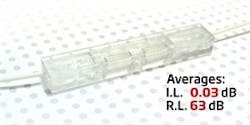KeyFibre offers KeyQuick MS201 mechanical splice
Spanish mechanical splicing technology developer KeyFibre has unveiled the KeyQuick MS201 Mechanical Splice. The splice features a proprietary flat cleave design that provides similar performance to angled cleaves at a lower cost. KeyFibre says the MS201 Mechanical splice features an updated core technology and simplified design that, when used with the KeyFibre KeyCleave cleaver, offers reflectance performance of Grade 1 specification at ≥ 60 dB. Meanwhile, average insertion loss is 0.03 dB. The “light-design” functionality of KeyQuick splice range enables technicians to guarantee all the connections using a visual fault locator (VFL). No additional tester is needed to verify loss performance, KeyFibre asserts. Thus, the MS201 offers the same performance as angled splices but at a lower capital investment, according to the company. For more information on connectors and suppliers, visit the Lightwave Buyer’s Guide.
